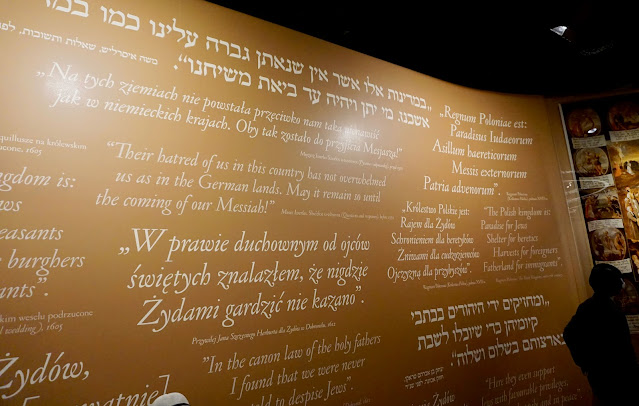 |
| Standing on a remnant of the former wall of the Warsaw Ghetto |
 |
| Honor to the heroes of the Warsaw Ghetto |
The 1940s valiant residents of Warsaw were with us in spirit today. As we trudged across the soggy city I could feel their resolve to try to survive, to try to prevail, to know that "whoever fights for his life has a chance of surviving."
 |
| Abandoned bombed out buildings from World War II |
 |
| Some facades of bombed buildings have been rebuilt to replicate the original designs. |
Through this yard you can see another portion of the former ghetto wall.
More photos of the ghetto wall fragments:
 |
| Map of small and large ghetto and commemoration plaque. |
We continued to the point of deportation of the ghetto Jews. As our guide pointed out, from where the Children's Hospital was to here was a very long walk and after a time people knew that "deportation" meant death at Treblinka.
This is the Umschlagplatz, the place of deportation.
Only first names are engraved on this wall of memory. Any one might be caught and taken to Treblinka, the hatred was that thick. Yet, any person and all persons are valuable humans. And so we can see ourselves, see our relatives, neighbors, all in this memorial.
Outside the POLIN Museum, the Museum of the History of Polish Jews, this monument stands. It is called the Monument to the Ghetto Heroes. We understand after our intense two weeks that so many became victims of the Nazi hatred, and living and dying were decisions made by others. Humans eradicating humanity. And so whether one was killed in a death camp, imprisoned in a concentration camp, or shot on a street, they are all heroes. The ghetto heroes who were gathered, given too few rations, stripped of their possessions, and exterminated will forever walk with the people who come here to learn about them and give them respect.
Inside this hands-on museum we spent a few hours making our final lesson, an exploration of a thousand years of Jews in Poland. We realize there are many moments and many opportunities that can make or break a people and a nation. We leave here considering our brothers and sisters around the world with new respect and new hopes for peace.
This is a photo image of the rubble that remained after the Warsaw Ghetto was destroyed. Barren. Empty. Hurting. With great respect for the memories of the devastating times, Warsaw has been rebuilt. The bricks, the buildings, the parks contain the breath of the heroes. May we carry it forward.
 |
| "Nothing. Absolutely nothing remains..." |
🥀















